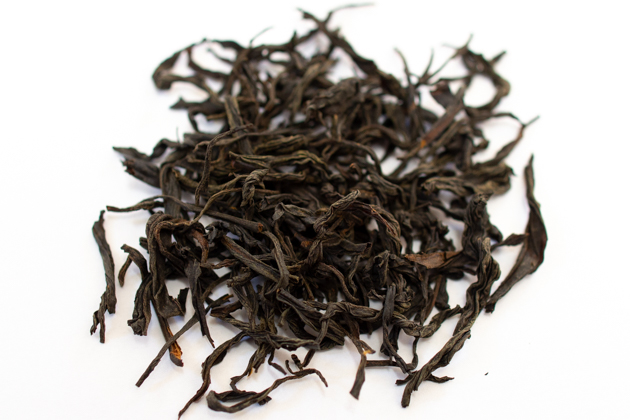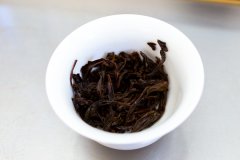What kind of tea variety is Keemun Black Tea authentic? Qimen Castanopsis carlesii leaf species is a big-leaf tea tree?
Origin: Qimen dried leaves: dark black, glossy buds with golden tip fragrance: light flowers, chocolate wine: bright orange-red flavor: fruity, long aftertaste, round and sweet tea varieties: Qimen bamboo leaf tea garden: Baita tea garden caffeine: less than 40% of a cup of coffee stored: stored in sealed, opaque packaging; shelf life in cool, dry places: 36 months

Qimen Maofeng is a special variety of Keemun Black Tea, which is produced in Qimen County, Anhui Province, China. It is famous for its unique aroma and shape and is recognized as one of the four best black teas in the world. Teavivre's excellent Qimen Maofeng represents the best of this already high-quality tea, and its reputation is fully demonstrated by its taste, aroma and appearance. Baita (which means Baita) Tea Garden (Baita Tea Garden) is located in Keemun Black Tea, Keemun Black Tea black tea from corn production, from Huangshan City. There are more than 9225 acres of eco-grade tea gardens, including nearly 3000 acres of organic certified gardens. Qimen Baita Tea Garden is the fifth generation inheritor of Keemun Black Tea's national intangible cultural heritage. Mr. Wang has more than 30 years of Keemun Black Tea planting and production experience. Over the years has been committed to the research and improvement of tea quality, in order to provide tea lovers with healthier and safer products. Mr. Wang once told us that he is still looking forward to bringing more and better tea to tea lovers in the future. Tea gardens are mainly concentrated in valleys between these mountains, ranging from 100 to 350 meters above sea level; forests account for about 80% of these valleys. The composition of Keemun Black Tea Castanopsis carlesii species consists of 31.11% tea polyphenols, 14.66% catechins 5.42% amino acids, and 44.72% water extraction. This is a nationally recognized variety, suitable for the production of black tea and green tea; this variety of kung fu black tea, taste tight, dark color, long-lasting aftertaste, has a unique fruit and flower aroma, especially known as "Qimen fragrance". Qimen has a short history (by Chinese standards), which began in Qimen in 1875. A failed bureaucrat named Yu Gancheng decided to give up his government job and start making tea instead. Because of the high demand and high price of black tea at that time, he went to Fujian to learn how to make black tea; when he returned to Anhui, he introduced black tea to the region, which before that only produced green tea. Over the next decade, the craft and the tea itself continued to improve, and in 1883 the tea, now known as Qimen black tea, was formed. The amazing taste and aroma of this tea, coupled with clever marketing techniques, made it quickly popular and generated huge demand in overseas markets in the UK and the United States.
Important Notice :
前街咖啡 FrontStreet Coffee has moved to new addredd:
FrontStreet Coffee Address: 315,Donghua East Road,GuangZhou
Tel:020 38364473
- Prev

What's the taste of an authentic wild Zhengshan race? How much is the Zhengshan race 500 grams in Tongmu pass?
Origin: Wuyishan season, Fujian Province, China: spring tea harvest date: April 28, 2021 dry leaves: leaves are thick, strong, tightly rolled into strips of aroma: the aroma of longan pleasant tea color: bright and clear red-orange flavor: rich honey and caramel flavor, smooth and rich taste, sweet potato tea varieties: wild camellia tea garden: tung wood
- Next

Introduction to the characteristics of fermentation treatment of coffee bean wine barrel evaluation of coffee bean flavor in Honduran sherry whisky barrel
Maybe when you drink coffee, you can smell and drink the flavor of fermented wine in the coffee, but this is only the similar flavor produced by the fermentation of coffee beans. If you drink a cup of coffee with a strong wine flavor, most of the coffee is fermented in a barrel, while in the front street coffee, there are a few.
Related
- The milk tea cup becomes smaller?! Overlord Tea Girl launches a new "Return to Yunnan" series
- Accused of selling counterfeit and high-priced coffee beans! Well-known boutique coffee brand "Oukelao" bowed and apologized!
- How to make espresso dumplings? Can I eat coffee and glutinous rice balls together?
- Save the unformed and stagnant powder cakes in one second! What is the problem with stagnant water in the powder bowl of the espresso machine?
- What does hand-brewed coffee stop mean? Why is it not recommended to make coffee by hand?
- Is it normal to smell like coffee? Why does coffee smell like alcohol? What's wrong with the strong smell of cold extract ice dripping ice brewed coffee?
- How to solve the problem that hand-brewed coffee extraction takes too long? Why is the water flowing so slowly when making coffee?
- The main points of making Australian white coffee, the proportion details, how does Australian white properly foam and blend the flowers?
- Can ice water make cold extract coffee? What is the difference between room temperature water and ice water for making cold coffee?
- What milk is best for making latte and white Dirty coffee? What is the difference between different brands of fresh milk and pure milk for making coffee?

